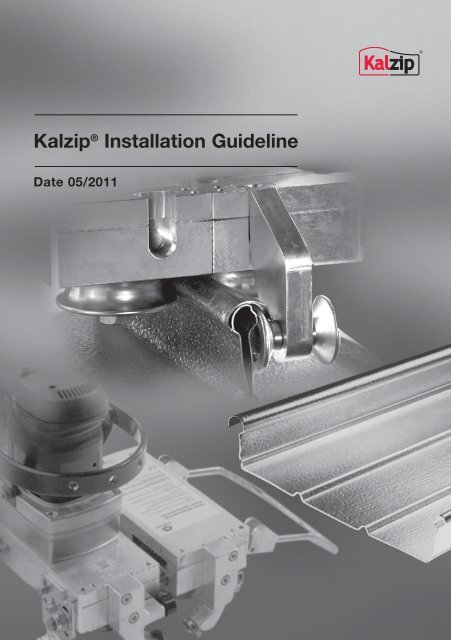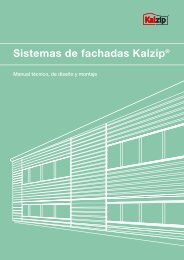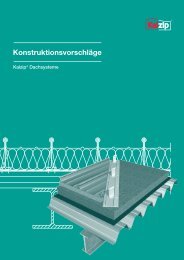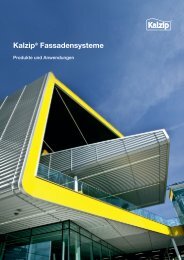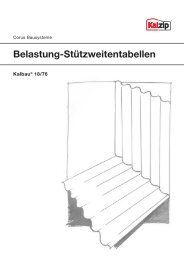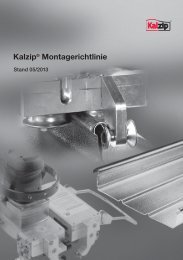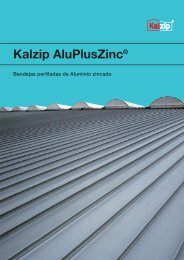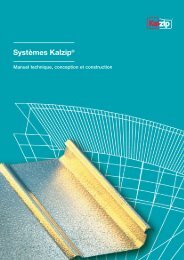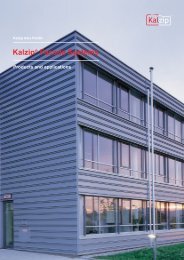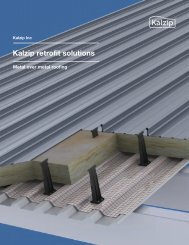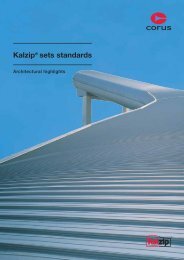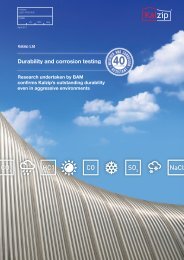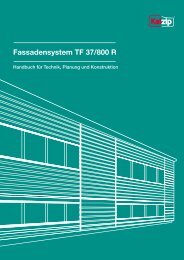Kalzip Installation Guideline
Kalzip Installation Guideline
Kalzip Installation Guideline
Create successful ePaper yourself
Turn your PDF publications into a flip-book with our unique Google optimized e-Paper software.
IntroductionIntroductionThis <strong>Kalzip</strong> <strong>Installation</strong> <strong>Guideline</strong> providesthe company with the "<strong>Installation</strong>Instructions" required by the building regulationsfor installing the profiled sheets.It provides information, general notes andexplanations, as well as detailed instructionsfor installing <strong>Kalzip</strong> aluminium roofand wall systems.The present <strong>Guideline</strong> provides a basisfor the correct, professional installationof <strong>Kalzip</strong> profiled sheets. It deals withthe usual cases of processing and use.Supplementary guidelines are availablefor special applications, such as theinstallation of <strong>Kalzip</strong> solar power systemsor the inclusion of roof lights (seewww.<strong>Kalzip</strong>.com/<strong>Installation</strong>.de).The <strong>Kalzip</strong> <strong>Installation</strong> <strong>Guideline</strong> constitutespart of a quality concept comprisingthe technical rules for installation in lightweightmetal construction (Fachregeln desMetallleichtbaus – Montage) published bythe IFBS (Industrieverband für Bausystemeim Metallleichtbau, a German industrialassociation for the lightweight metal constructionsector) and the ALZ (Aluminium-Zentrale e.V.) leaflet A 7 ("Richtlinie fürdie Verlegung von Aluminium-Profiltafeln"),which provides a guideline for the installationof aluminium profiled sheets.The applicable building authorities regulations,standards, accident preventionregulations, rules for health and safetyand other similar guidelines have beentaken into account.The images and processing descriptionsincluded here represent the present stateof the technology. They do not take intoaccount any specific application. Were serve the right to make technicallyappropriate modifications to the designsor installation procedures for the sake ofour high quality standards and of progress.Due to the dynamism of product developmentsand improvements, the <strong>Kalzip</strong>printed documents do not always correspondto the actual products. The currentlyvalid version of the <strong>Installation</strong> <strong>Guideline</strong>can be downloaded from the Internet atwww.kalzip.com.In the event of disagreement betweenthose responsible for the construction,this <strong>Guideline</strong> shall be the standard forthe correct and professional method forinstalling <strong>Kalzip</strong>.The fact that this <strong>Guideline</strong> has beenreleased does not obviate the personalresponsibility of those concerned for theiractions. Moreover, <strong>Kalzip</strong> GmbH cannotaccept liability for any errors that this<strong>Guideline</strong> may contain. In the light ofpresent knowledge it does neverthelessensure correct technical performance.Compensation claims cannot be basedon its application.March 2011Copyright <strong>Kalzip</strong> GmbH
ContentsOverviewPage1.0 Introduction1.0 Introduction 82.0 The System2.0 The System 92.1 <strong>Kalzip</strong> range of applications 102.1.1 <strong>Kalzip</strong> non-ventilated roof on trapezoidal steel deck 112.1.2 <strong>Kalzip</strong> non-ventilated roof on purlin with trapezoidal sheets inner skin 112.1.3 <strong>Kalzip</strong> non-ventilated roof on timber rafters with visible timber lining 122.1.4 <strong>Kalzip</strong> ventilated roof with common rafter insulation 122.2 <strong>Kalzip</strong> DuoPlus ® 100 and <strong>Kalzip</strong> Duo ® 100 132.2.1 <strong>Kalzip</strong> DuoPlus 100 132.2.2 <strong>Kalzip</strong> Duo 100 142.2.3 <strong>Kalzip</strong> DuoPlus 100 or <strong>Kalzip</strong> Duo 100 on steel trapezoidal deck 152.2.4 <strong>Kalzip</strong> DuoPlus 100 or <strong>Kalzip</strong> Duo 100 on timber 162.2.5 <strong>Kalzip</strong> DuoPlus 100 or <strong>Kalzip</strong> Duo 100 on concrete 172.2.6 <strong>Kalzip</strong> DuoPlus 100 or <strong>Kalzip</strong> Duo 100 on aerated concrete 182.3 <strong>Kalzip</strong> NatureRoof 192.4 <strong>Kalzip</strong> FOAMGLAS ® System as a standard and combined solution 202.5 <strong>Kalzip</strong> AF 212.5.1 <strong>Kalzip</strong> AF with ProDach-insulation on trapezoidal steel deck 212.5.2 <strong>Kalzip</strong> AF with ProDach-insulation on timber rafters with formwork 222.5.3 <strong>Kalzip</strong> AF with common rafter insulation 222.5.4 <strong>Kalzip</strong> AF on FOAMGLAS ® insulation 223.0 Transport · Storage · Inspection3.1 Transporting to the building site or unloading at a designated area 233.2 Unloading on the building site 233.3 Storage on the building site 243.4 Checking incoming materials 243.5 Special instructions: transport, storage and installationof <strong>Kalzip</strong> profiled sheets made from AluPlusZinc 243.6 Noise adsorber and anti-condensation coatings 254.0 Clip installation4.1 Attachments 264.2 Clip positioning 31
ContentsOverviewPage5.0 Installing <strong>Kalzip</strong> · renovating with <strong>Kalzip</strong>5.1 Wind, weather 365.2 Positioning 375.3 Corrosion protection 375.4 <strong>Installation</strong> 375.5 Fixed point design: <strong>Kalzip</strong> aluminium clip / <strong>Kalzip</strong> composite clip 385.6 Zipping procedure 405.7 Renovating existing roofs with <strong>Kalzip</strong> profiled sheets 426.0 Connections6.1 Ridge 436.1.1 Upward fold 436.1.2 Ridge closure 436.1.3 Closure filler 436.1.4 Spacer section / sliding element 446.1.5 Ridge cover plate 446.2 Gable end 456.2.1 Gable end channel 456.2.2 Gable end clip 456.2.3 Gable end support rail 466.2.4 Gable end profile 50/65 (option) only for flat roofs 466.2.5 Cover plate 476.3 Eaves closure and static edge reinforcement 486.3.1 Gutter overhang 486.3.2 Drip angle 486.3.3 Folding 506.3.4 Sealing the eaves 507.0 <strong>Installation</strong>s7.1 Skylights / smoke extractors 517.2 Vents 527.3 <strong>Kalzip</strong> roof anchor 527.4 Fall arrest systems 527.5 Walkways / steps 537.6 Solar systems 537.7 Seam clamps (Cable clip, Seam clip stainless steel) 53
ContentsOverviewPage8.0 Welding · cutting · bending8.1. TIG welding 548.1.2 Welding preparation 548.2 Welding backing strip 548.3 Cutting 558.3.1 Cutting and sawing 558.3.2 Cut-off discs 558.4 Folding 559.0 Useful hints and advice9.1 <strong>Installation</strong> template for installing clips 569.2 Preassembly of the clips on top hat profiles 569.3 Storing long profiled sheets 569.4 <strong>Installation</strong> with several installation groups 579.5 Protection when drilling through U disc 579.6 Roof projections with clip bars 589.7 Roof projections without clip bars 599.7.1 Requirements for installation 599.8 Roof projections constructed from <strong>Kalzip</strong> profile sheets 609.9 Removing dirt 6110.0 Special tools10.1 Tools and accessories 6211.0 System components and accessories<strong>Kalzip</strong> composite clip type E 63Clip bar 64Clip bar curved 64Fixed point clip bar including fastening holes 64Thermal barrier polyamide 64Rotatable clip 65Rotatable clip rail perforated 65Gable end channel 65Gable end clip 50/65 66Gable end profile 50/65 66Gable end support rail 66Sliding element 67
Introduction1.01.0 IntroductionArea of applicationThis <strong>Installation</strong> <strong>Guideline</strong> specifies thecorrect method for installing <strong>Kalzip</strong> profiledsheets, the fasteners and accessories.Installing the profiled sheetsThe profiled sheets may only be installedby skilled workers employed by the manufactureror by companies who havebeen properly instructed and authorizedby the manufacturer. The manufacturer,or whoever is responsible for laying theprofiled sheets, must prepare installationinstructions describing how the elementsare to be laid, and must give them to theinstallation companies.ApprovalIn accordance with building regulations<strong>Kalzip</strong> can only be installed by companiesapproved and trained by the manufacturer.The general building inspectorate approvalmust be present at the constructionsite. This can be obtained from the manufacturer'sworks. It contains importantnotes on the qualifications required forthe installing workers, on accident prevention,on walkability and on the fasteningelements. It is essential that these instructionsare followed. Other regulations fromthe building authorities, professional andtrade association etc. are not consideredhere. Familiarity with them is assumed.Preparatory workIn accordance with building regulations,certification of the stability and suitabilityof use is to be provided for each individualcase. An installation plan must bederived from these certificates, and mustalso be available on-site. The contents ofthe installation plans is regulated by DIN18807.Before work starts, the geometry andthe dimensions of the preceding works,as handed over, must be comparedwith the inspected plans. Contact thefactory immediately if there are anydeviations. Deviations must be reportedto the client in writing in accordancewith DIN 1961, VOB Part B, §4,Paragraph 3.General InstructionsThe instructions, recommendations andrequirements correspond to the presentlevel of knowledge. They are based onthe experience of the manufacturing worksas well as the practical experience of thebuilding companies and are provided tothe best of our knowledge. Therefore, noenforceable claims for defects, errors orincompleteness can be derived.Special toolsBefore commercing fixing work, check thezipping machine, hand closing tool, ridgefolding tool and unzipping device. Thezipping machine must close fully and theroller sets must be correctly fitted.8
The System2.0 The System<strong>Kalzip</strong> is a system of aluminium sheetsdesigned for low pitched roofs to a minimumof 1.5 degrees when running fromridge to eaves as well as for steeperpitches.333429502.0<strong>Kalzip</strong> profiled sheets are available in avariety of construction widths and canbe manufactured in different shapes suchas straight, convex, concave, convexand concave curved, as well as XT freeformshapes to suit the roof geometry.3055065The aluminium sheets are fixed with clipswhich are locked into the seam and concealedby the adjacent sheet. This meansthat the fixings are positioned beneath theroof covering.33340065As a result of this, the fixings are locatedunderneath the roof cladding. It is notpenetrated. The clips permit the slidingmovements of the <strong>Kalzip</strong> profiled sheetsthat occur due to changes of temperature.The sliding movements must not beimpaired by connection to other structuralelements (chimneys etc.).50033365656543465422659
The System2.1.1 <strong>Kalzip</strong> non-ventilated roof ontrapezoidal steel deckThis very economical roof system is usedboth for industrial and residential buildings.In order to make sure that there areno air cavities under the <strong>Kalzip</strong> roof skin,compressible thermal insulation is used.Incorporated within the roof system theinsulation material is compressed byapprox. 20 mm.2.0R’w35 dB (A)*The loading on the top skin is not transferredto the inner skin as an evenly distributedload but rather at set points viathe secret fixing clips. The design roofload must be increased by 15 % whendimensioning the trapezoidal steel sheets.The clips must be staggered on the innersheet to make sure that the load is evenlydistributed across all corrugations of theinner sheet.2.1.2 <strong>Kalzip</strong> non-ventilated roof onpurlin with trapezoidal sheets innerskinIf the roof is supported on purlins, theinner sheet has to be oriented parallel tothe top layer. If the module of the innersheet does not correspond with the <strong>Kalzip</strong>elements a top hat section must beinstalled to support the clips. If the <strong>Kalzip</strong>sheets can span the existing spacing ofthe purlins, the top hat sections will bepositioned on top of the purlins. In thatcase, the inner skin will only serve tohold the vapour and convection barrierand the thermal insulation.R’w35 dB (A)*For larger purlin spans additional top hatsections are required. In this instance, partof the load needs to be transferred bythe inner sheet.11
The System2.02.1.3 <strong>Kalzip</strong> non-ventilated roof ontimber rafters with visible timber liningIn residential buildings the roof systemis frequently built-up using wooden rafterswith visible timber lining. This is advantageous,because:1. there is a clear separation betweenthe trades of carpenters, roofers etc.2. a continuous flat vapour and convectionbarrier can be installed.R’w38 dB (A)*The clips can only be fixed directly inthe timber lining if this has a minimumthickness of 23 mm. A minimum thicknessof 19 mm applies for flat pressboards, and 18 mm for OSBs. In bothcases the fastener is visible from below.If the timber lining is too thin, then atimber purlin must be installed over thelining and attached to the rafters.2.1.4 <strong>Kalzip</strong> roof withcommon rafter insulationR’w35 dB (A)** varies depending on thicknessand material qualitiesWith roofs featuring a structure as shownon the left it is quite often impossible todesign the roof as a non-ventilated versionbecause the distances are too greatbetween the vapour and convection barrierand the roof skin. Consequently perfectfunctioning of the vapour and convectionbarrier is a prerequisite condition.Sufficient ventilation is essential for efficientdispersal of any condensation thatmight occur.If there are any risks of wind driven snowit may be necessary to install a film barrierto prevent snow from coming into contactwith the insulating material.12
The System2.2 <strong>Kalzip</strong> DuoPlus 100and <strong>Kalzip</strong> Duo 100The precise spacings along with theposition of the rail and the number ofconnection elements are given in theinstallation plan.2.02.2.1 <strong>Kalzip</strong> DuoPlus 100The <strong>Kalzip</strong> DuoPlus 100 system combinesthe advantages of rigid insulationwith the constructional possibilitiesoffered by the conventional <strong>Kalzip</strong> roofingsystem.R’w43 dB (A)*The special design is almost cold-bridgefree and has excellent sound absorptionproperties. An aluminium rail is placedon the 100 mm thick rigid thermal insulationand is fixed onto the substructurethrough the insulation. Special clips areinserted in the rail and are adjusted tosuit the respective conditions. Connectionof the individual clips to the rail is notnecessary.The patented and type-tested systemconsists of rigid thermal insulation,DuoPlus rail, DuoPlus clip and connectingelements to secure the DuoPlus rail,the compressible heat insulation and the<strong>Kalzip</strong> profiles sheets.13
The System2.02.2.2 <strong>Kalzip</strong> Duo 100 In the case of the <strong>Kalzip</strong> Duo 100 system,R’w 41 dB (A)*economic considerations are of centralimportance. For reasons of cost, a fulllayer of rigid thermal insulation is not necessary.If there are no specific sound insulationrequirements then the <strong>Kalzip</strong> Duo100 system can be used, whereby a fulllayer of rigid thermal insulation is not necessary.The base for the <strong>Kalzip</strong> DuoPlus100 is simply provided by rigid insulationstrips with a width of 24 cm and a thicknessof 10 cm. The resulting spaces arefilled with soft heat insulation or low-pricedrigid insulating material.In the case of <strong>Kalzip</strong> DuoPlus 100, rigidthermal insulation only needs to be used inthose areas specified by the statisticalrequirements. The rigid thermal insulationis replaced by a layer of soft insulation inall areas where no reduction in snow loadsis required. This type of roof design, whichdoes not influence heat transfer or loadbearing saftey, is recommended if thereare no specific sound insulation requirements.When the rigid spacer strips are laidunderneath the DuoPlus rails, it is notnecessary to carry out the time-consumingtask of marking-up, as the contoursof the steel trapezoidal profiles are visiblethrough the vapour and convection barrier.14
The SystemThickness: 100 mm2.2.3 <strong>Kalzip</strong> DuoPlus 100 or <strong>Kalzip</strong>Compressive strength:10 70 kN/m2Duo 100 on steel trapezoidal profile <strong>Kalzip</strong> Duo 100– installed in 24 cm wide strips• Liner sheet:Fischer trapezoidal liner sheetsSheet thicknesses: t = 0.88 mm1.00 mm<strong>Kalzip</strong> DuoPlus 100– installed as a full layer• DuoPlus railsHole diameter 6.8 mm1.25 mm1.50 mm • DuoPlus clipsCross sections: FI 90/305FI 100/275FI 135/310FI 144/287FI 150/280FI 165/250Clip type complies with the requirementsof the energy-saving directives• Connecting elements forDuoPlus railsSFS intec SD2-S16-6.0 x L(In the case of a <strong>Kalzip</strong> Duo 100 roof,Alternative Fischer acoustic sheets, the spaces between the 24 cm wideperforated: AK 100/275AK 135/310AK 150/280AK 165/250strips should be filled with insulatingfelt.)• Rockwool insulation in accordancewith DIN EN 13162• <strong>Kalzip</strong> vapour and convection barrier,self adhesiveEuro Class A1 in accordance withDIN EN 13501 – non-combustibleApplication type: WD in accordance• High-density thermal insulation witha highly compressed surface inaccordance with DIN EN 13162Euro Class A1 in accordance withwith 18165Thermal conductivity group (WLG) 040Thickness complies with the requirementsof the energy-saving directivesDIN EN 13501 – non-combustibleApplication type: WD in accordance • <strong>Kalzip</strong> aluminium profiled sheetswith DIN 18165Thermal conductivity group (WLG) 0402.015
The System2.02.2.4 <strong>Kalzip</strong> DuoPlus 100 or<strong>Kalzip</strong> Duo 100 on timber• Fasteners for the DuoPlus rail:SFS SD2-S-S16-6.0 x 165 screw orwood screws in accordance with DIN1052 or thread forming screws suitablefor wood in accordance with DIN18807 or local building standards.Sealing washer diameter min. 16 mmScrew depth min. 26 mm• Liner sheet:Soft wood minimum sorting class S 10• <strong>Kalzip</strong> vapour and convectionbarrier H• High density thermal insulationwith highly compressed surface inaccordance with DIN EN 13162Euro Class A1 – non-combustibleApplication type: WD in accordancewith DIN 18165Thermal conductivity group (WLG) 040Compressive strength: σ 1070 kN/m 2Thickness: 100 mm<strong>Kalzip</strong> Duo 100– installed in 24 cm wide strips<strong>Kalzip</strong> DuoPlus 100– installed as a full layer• DuoPlus railHole diameter 6.8 mm• DuoPlus clipClip type complies with the requirementsof the energy-saving directives(no composite clip possible)• <strong>Installation</strong>:The max. screw spacing is 50 cm. Thescrews should be arranged in a staggeredmanner in the rail holes. The railsshould be orientated at a right angle orat least at an angle of 45° to the <strong>Kalzip</strong>ribs. The rail spacings correspond tothe load carrying capacity of the <strong>Kalzip</strong>profiled sheets. Two screws should beused per fixing point in the edge andcorner areas of the roof. If the rail is toact as a single-span support (e.g. fittingpiece at the end of a row), then it mustbe no longer than 40 cm. (In the caseof <strong>Kalzip</strong> Duo 100 roofs, the spacesbetween the 24 cm wide strips shouldbe filled with insulating felt.)• Rockwool insulating felt inaccordance with DIN EN 13162Euro Class A1 – non-combustibleApplication type: WL in accordancewith DIN 18165Thermal conductivity group 040Thickness complies with the requirementsof the energy-saving directives• <strong>Kalzip</strong> aluminium profiled sheets16
The System2.2.5 <strong>Kalzip</strong> DuoPlus 100 or<strong>Kalzip</strong> Duo 100 on concrete• DuoPlus clipClip type complies with the requirementsof the energy-saving directives2.0• Installed on 10 cm rigid thermalinsulation or directly ontoconcrete B 15 liner• Fasteners for the DuoPlus rail:SFS MBRK-X-S4-H18-10x80 andSFS MBR-X-S4-HX-10x160Predrill diameter 10 mmThe shorter length of plug is designedfor thermal insulation with a thicknessof 20 mm (or equivalent plug withadmissible FT 1.2 kN, approved bythe building authorities, stainless steelfastener).• <strong>Kalzip</strong> vapour and convection barrier• High-density thermal insulation witha highly compressed surface inaccordance with DIN EN 13162Euro Class A1 – non-combustibleApplication type: WD in accordancewith DIN 18165Thermal conductivity group (WLG) 040Compressive strength: 70 kN/m210Thickness: 100 mm<strong>Kalzip</strong> Duo 100– installed in 24 cm wide strips<strong>Kalzip</strong> DuoPlus 100– installed as a full layerAvoid contact corrosion when fixingdirectly onto concrete. Due to the roughconcrete surface, the use of a 20mmthick separating layer made from rigidthermal insulation is recommended.• DuoPlus railHole diameter 10.5 mm• <strong>Installation</strong>:Maximum plug spacing 50 cm. Thescrews should be arranged in a staggeredmanner in the rail holes. Therails should be orientated at a rightangle to the <strong>Kalzip</strong> ribs. The rail spacingsare determined according to staticcalculations. Individual verification isrequired for other specifications. If therail is to act as a single-span support,then it must be no longer than 40 cm.(In the case of <strong>Kalzip</strong> Duo 100 roofs,the spaces between the 24 cm widestrips should be filled with insulating felt.)• Rockwool insulating felt inaccordance with DIN EN 13162Euro Class A1 – non-combustibleApplication type: WL in accordancewith DIN 18165Thermal conductivity group 040Thickness complies with the requirementsof the energy-saving directives• <strong>Kalzip</strong> aluminium profiled sheets17
The System(In the case of <strong>Kalzip</strong> Duo 100 roofs,the areas between the 24 cm widestrips should be filled with insulatingfelt.)• Rockwool insulating felt inaccordance with DIN EN 13162Euro Class A1 – non-combustibleApplication type: WL in accordancewith DIN 18165Thermal conductivity group 040Thickness complies with the requirementsof the energy-saving directives2.0• <strong>Kalzip</strong> aluminium profiled sheets2.3 <strong>Kalzip</strong> NatureRoof All roof designs described above can betransformed into a <strong>Kalzip</strong> NatureRoofproviding that the design requirementsare taken into consideration and <strong>Kalzip</strong>65/333 is being used.<strong>Kalzip</strong> NatureRoof comprises an efficientdraining mat to control the integral watermanagement and a special substratesup porting a vegetation layer for extensivelandscaping with sedum plants.19
The System2.02.4 <strong>Kalzip</strong> FOAMGLAS ® 1) System asa standard and combined solutionThis roof design and the system componentsused are particularly suitable forbuilding projects which place highdemands on ensuring that the roof systemis free from condensation and wherethere is therefore a permanent risk ofcondensation formation.The FOAMGLAS ® slabs are bonded todifferent substructures using either acold-bonding agent or hot bitumen. Inorder to attach the compound clips, thegalvanized steel claw plates are insertedunder heat in a fixed installation plantaking into account the respective roofgeometry. The compound clips areinstalled on the claw plates using therecommended fastening elements.The <strong>Kalzip</strong> FOAMGLAS ® System offers ahigh level of energy efficiency as thethermal insulation is airtight and imperviousto water vapour. What’s more, thereis no mechanical attachment betweenthe <strong>Kalzip</strong> profiled sheets and the supportingstructure. This means there is nocoldbridging. As Foamglas is imperviousto moisture penetration the insulationcan also act as a watertight substructure.The <strong>Kalzip</strong> profiled sheets are installed inthe usual manner and are friction-fittedtogether. In order to ensure economicefficiency, the thickness of the compressiblethermal insulation can be varied.Foamglas has a minimum thicknessof 80 mm.<strong>Kalzip</strong> FOAMGLAS ® Systemas a standard solution<strong>Kalzip</strong> FOAMGLAS ® Systemas a combination solution1)FOAMGLAS ® is a registered trademark of the German company FOAMGLAS ® GmbH.20
The System2.5 <strong>Kalzip</strong> AF<strong>Kalzip</strong> AF profiled aluminium sheets areespecially designed for installation aboverigid support layers. Under the trade mark“ProDach insulating system” Rockwooloffers an accessible, compression-proof,water repellent mineral wool insulatingboard featuring a special fixing system.<strong>Kalzip</strong> AF profiled aluminium sheets arenot only used in combination with theProDach-insulation system but may alsobe used with FOAMGLAS ® insulation andtimber lining.The twin layer ProDach insulatingboard: the ideal base for <strong>Kalzip</strong> AF• non combustible• very efficient thermal insulation andacoustic properties• dimensionally stable• vibration dampening• open for diffusion• high accessibility during installationand maintenance• safe absorption of pressure andsuction loadsbeing fixed directly to the substructurethe skin is fixed instead to special U-railsembedded in the insulation material.The stainless steel system fasteners connectingthe U-rails to the substructure ofthe roof penetrate the insulation materialonly locally. This almost entirely eliminatesthe effect of cold / heat and sound bridging.2.5.1 <strong>Kalzip</strong> AF with ProDachinsulationon trapezoidal steel deckIn order to meet increased demands forsound reduction and to reduce cold /heat bridges it is advisable to install theProDach Insulation System.Fixing rails are embedded in the top-sideof the insulation material and fixed to thetrapezoidal steel deck.2.0AssemblyThe corrosion-proof and weather resistant<strong>Kalzip</strong> AF aluminium external skin isfixed with clips in the usual way. However,and this is the distinctive feature of theProDach insulation system, rather thanR’w42 dB (A)** varies depending on thicknessand material qualities21
The System2.02.5.2 <strong>Kalzip</strong> AF with ProDachinsulationon timber rafters withformworkWith this type of roof, a timber liningwhich remains visible serves as asupporting element. This structure hasproved to be ideal for residential buildingsand other buildings of similar use.The potential extends from public buildingsto multi-purpose halls and sportsarenas.The rails are invisibly fixed to the rafters.There are no visible joints or fasteners.R’w45 dB (A)*2.5.3 <strong>Kalzip</strong> AF with commonrafter insulationThis structure is comparable to tradi tionalstanding seam systems. It is frequentlyused in order to minimise the overallheight of the roof structure. If there is anair gap under the timber lining adequateventilation is essential. With this in mind,we recommend filling the total height ofthe rafters with insulating material forefficient performance. A vapour and convectionbarrier beneath the thermal insulationis also of critical importance.2.5.4 <strong>Kalzip</strong> AF onFOAMGLAS ® insulation<strong>Kalzip</strong> AF can also be installed on theproven FOAMGLAS ® insulation (see p. 20).There are different ways of building up theroof structure. The method shown herewith the L-shaped claw plate does notuse any mechanical connection betweenthe <strong>Kalzip</strong> profiles and the support structureand is free from cold-bridging. Theplastic clips used allow optimum lubricatingof the profiles in the case of thermalelongation.* varies depending on thickness and material qualities22
Transport · Storage · Inspection3.0 Transport · Storage · Inspection3.1 Transporting to the building siteor unloading at a designated areaIn general, <strong>Kalzip</strong> sheets are transportedby road.3.2 Unloading on the bulding site• General rule: access to the unloadingpoint must be guaranteed.• Before delivery, the person who hasplaced the order must check the siteand it may also be necessary for thetransport agent to check the route.• Delivery dates must be agreed withthe supplier.• Packages can weigh up to 3.5 t, plusthe weight of the cross beam. (Checkcrane capacity!)• Make prior arrangements for liftinggear such as cranes, fork lift trucks,spreader beams, sling belts, etc.Protect edges of pallets if sling beltsare used. Sources of supply for slingbelts can be supplied on request.• Maximum load per suspension pointmustnot exceed 0.8 t!• Projecting ends exceeding 4.50 mmust be avoided!• Precurved <strong>Kalzip</strong>: take special carewhen unloading / taking pre-curved<strong>Kalzip</strong> onto the roof. You must allowfor the fact that extra sling belts needto be used. In many cases, the palletscannot be placed directly on the substructure.The profiled sheets have tobe lifted onto the roof individually or insmall bundles.Owing to the different sheet upstands,pallets must be stored in accordancewith the direction of laying to avoidhaving to turn the sheets in the roof.Instalation has to be made in the directionof the sheets’ small upstands.>6m>10m
Transport · Storage · Inspection3.03.3 Storage on the building sitePackages are to be stored in an inclinedposition and protected against theweather. Building site stores, includingthose on the roof, must be roofed overand well-ventilated. Condensation mustbe avoided. Opened packages must becovered over again during interruptionsto the assembly.3.4 Checking incoming materialsObtain confirmation of any material andpackaging deficiencies from the forwarderand notify the supplier immediately.Check that the number of packages andtheir contents agree with the deliverydocuments. Inform the supplier immediatelyof any discrepancies in dimensionsor quantities, etc. Period of time in whichtransport damages have to be claimed:Maximum 1 week after arrival on thebuilding site although an earlier claim isadvantageous to all parties.• When storing on the roof, ensure thatthe load bearing capacity of the substructureis sufficient.• Exercise caution when opening packagesstored at an angle: there is dangerof sheets sliding sideways and / orin the direction of slope.• Always cover translucent sheets toprotect them from dirt and directsunlight. Magnifying glass effect maycause distortion and discoloration.• Permissible length tolerances for<strong>Kalzip</strong> sheets:for sheets of up to 3 m in length:+ 10 mm / - 5 mmfor sheets of over 3 m in length:+ 20 mm / - 5 mmTolerances are based on productiontemperature of 20 °C.3.5 Special instructions:transport, storage and installationof <strong>Kalzip</strong> profiled sheets made fromAluPlusZinc• Always ensure that AluPlusZinc istransported and stored in a dry andventilated condition. Open transportationin unsettled weather conditionsshould be avoided.24
Transport · Storage · Inspection• During storage, ensure that condensationdoes not form inside the coils orstacks. Storage in damp or warmlocations, or locations where the temperatureis subject to frequent change,should be avoided.• Building site stores must be coveredand ventilated – also on the roof.During production on-site the unprotectedsurface must not be exposedto rain. Roll formed profiled sheetsshould be laid immediately.• The protective film on the profiledsheets not only protects them duringtransport, but also while they are beingzipped. It is important to make surethat this film is removed from thesmall seam prior to zipping.The film is to be removed at the latest2 weeks after delivery, or immediatelyafter the zipping process. After this theprofiled sheet should not be walked on.• The profiled sheets must not beallowed to come into direct or indirectcontact with other materials whichhave a corrosive effect on aluminiumand / or zinc.• Do not allow the surface ofAluPlusZinc to come into direct contactwith wet coverings. No objects(e.g. including damp thermal insulation)should be placed or stored onAluPlusZinc.• Never attempt to remove dirt usingabrasive or corrosive materials.• Weld seams can be carefully paintedover with a fine paint brush(RAL 7030 – weathered “new”;RAL 7023 – weathered “old”;zinc dust paint – changing grey tonedepending on angle of vision).3.6 Noise adsorbing andanti-condensation coatings• Do not allow the coatings to come intodirect contact with dirty or wet surfaces.• The coated surfaces must not beexposed to direct rain.• Ensure adequate ventilation duringstorage.3.025
Clip installation4.0 Clip installation4.04.1 Attachments<strong>Kalzip</strong> clips are attached to the substructureusing stainless steel screws oraluminium bulbtite blind rivets. Only theapproved fasteners must be used. As ageneral rule, a screw or rivet is arrangedon each side of the web. <strong>Kalzip</strong> fastenersand bulbtite blind rivets should be arrangedin a diagonal manner. The number ofattachments can also be increased in theedge areas of the roof. These details areoutlined in the installation plan.Use of spacer caps in combinationwith the <strong>Kalzip</strong> composite clipThe <strong>Kalzip</strong> composite clips can be combinedwith spacer caps (DK) in order tocompensate for height tole rances. Acombination is thereby permissible onlyin following variants.+Please note:The number and the positioning of thefastener elements are to be found in theinstallation plan or in the static calculations!Holes for self-tapping screws or self drilling screwswith diameter > 6 mm and sealing washerHoles for <strong>Kalzip</strong> drilling screwsType SDK or bulbtite rivetsComposite clip + DK 10Combination for the desired clip height+Composite clip + DK 10 + DK 5Max. combination for the desired clip heightand to compensate for height tolerances+Composite clip + DK 5to compensate for height tolerancesFixing elements:1. self-tapping screws2. drilling screws3. bulbtite rivet+Composite clip with several DKs– not permissible26
Clip installationTimber purlins or spacersAs a general rule, the timber must bepredrilled when using screws. This is notnecessary when self-drilling screws areused.Self-drilling screw:e.g. SFS-SDK2 –S-377-6.0 x 45Timber lining minimumthickness 23 mmwithour spacer capself-drilling screw:e.g. SFS-SXW-S16-6.5 x 50ore.g. SFS-SDK2-S-377-6.0 x 354.0with spacer cap DK 5<strong>Kalzip</strong> self-drilling screw:e.g. SFS-SDK2-S-377-6.0 x 45with spacer cap DK 10 orspacer cap DK 10 + DK 5self-drilling screw:e.g. SFS-SXW-S16-6.5 x 50orself-tapping fastener:e.g. SFS-TDA-S-S16-6.5 x 64predrilled with ø 4.8 mmore.g. SFS-SDK2-S-377-6.0 x 60Through the lining into purlinsor rafterswithout spacer cap orwith spacer cap DK 5 orspacer cap DK 10 orspacer cap DK 10 + DK 5self-tapping fastener:e.g. SFS-TDA-S-S16-6.5 x 76predrilled with ø 4.8 mm27
Clip installationOn steel purlin with seamthickness < 6 mmwithout spacer capself-drilling screw:e.g. SFS-SX14/12-S16-5.5 x 38with spacer cap DK 5self-drilling screw:e.g. SFS-SX14/12-S16-5.5 x 384.0with spacer cap DK 10 orspacer cap DK 10 + DK 5self-drilling screw:e.g. SFS-SX14/38-S16-5.5 x 61,SFS-SX14/4-38-S16-5.5 x 61or self-tapping fastener:e.g. SFS-TDB-S-S16-6.3 x 38pre-drill appropriately for thethickness of the seamAttention:In order to guarantee that the clip isproperly fastened it is necessary toensure that no drilling swarf gets betweenthe clip and the supporting construction.(This can be achieved by, for instance,fitting the clip with the aid of a grip wrench.On steel purlin with seamthickness > 6 mmself-tapping fastener:e.g. SFS-TDB-S-S16-6.3 x Lpre-drill appropriately for thethickness of the seam)Attention:Be sure to remove drilling swarf. Selfdrillingscrews no longer recommended.28
Clip installationOn steel trapezoidal profile(thickness max. 1.25 mm)without spacer cap orwith spacer cap DK 5<strong>Kalzip</strong> self-drilling screw:e.g. SFS-SDK2-S-377-6.0 x 35or bulbtite blind rivet:e.g. SFS-RV-6604-6-12Wwith spacer cap DK 10 orSpacer cap DK 10 + DK 5<strong>Kalzip</strong> self-drilling screw:e.g. SFS-SDK2-S-377-6.0 x 454.0On ProDach rail(thickness 1.15 mm)without spacer capwith spacer cap DK 5<strong>Kalzip</strong> self-drilling screw:e.g. SFS-SDK2-S-377-6.0 x 35or bulbtite blind rivet:e.g. SFS-RV-6604-6-12Wwith spacer cap DK 10 orSpacer cap DK 10 + DK 5<strong>Kalzip</strong> self-drilling screw:e.g. SFS-SDK2-S-377-6.0 x 45<strong>Kalzip</strong> clips must not be attached using hot fired pins!29
Clip installationOn a steel top hat profile(thickness 1.50 mm)<strong>Kalzip</strong> self-drilling screw:e.g. SFS-SDK3-S-377-6.0 x 30or self-drilling screw:e.g. SFS-SX3/10-S16-5.5 x 28or bulbtite blind rivet:e.g. SFS-RV-6604-6-12W4.0with spacer cap DK 5self-drilling screw:e.g. SFS-SDK3-S-377-6.0 x 30or self-drilling screw:e.g. SFS-SX3/15-S16-5.5 x 38or bulbtite blind rivet:e.g. SFS-RV-6604-6-12Wwith spacer cap DK 10 orspacer cap DK 10 + DK 5self-drilling screw:e.g. SFS-SX3/20-S16-5.5 x 52<strong>Kalzip</strong> DuoPlus 100 / Rotatable clip and<strong>Kalzip</strong> DuoPlus 100 / Rotatable cliprail,perforatedWith the development of the DuoPlus railand <strong>Kalzip</strong> the DuoPlus clip, a total solutionhas been created for the secure andconvenient installation of the mountingelements for the <strong>Kalzip</strong> profiled sheets.After the rigid insulation has been installed,the rails are aligned according to the calculationsand are mounted in the steeltrapezoidal profile substructure using theSD2-S-S16-6.0 x 4 fixing element fromSFS intec. The approved dowel must beused for applications on concrete or aeratedconcrete. The DuoPlus clips are thenmanually screwed in.30
Clip installation4.2 Clip positioningGeneralThe distance between one clip and thenext must never be less than the widthof the <strong>Kalzip</strong> profiled sheet.The maximum positive tolerance is about3.0 mm. The clips must be positioned asfar apart as possible on rounded <strong>Kalzip</strong>profiled sheets. That is therefore 336 mmin the example below. Otherwise it is notpossible to rule out the possibility ofbuckling. For those of <strong>Kalzip</strong> profiledsheets with a thickness of t = 1.2 mm,the positioning dimension is to beincreased by 2 mm above the nominaldimension, in this case 335 mm.With <strong>Kalzip</strong> AS and AF profiled sheets,an in crease in construction width of upto 20 mm must be taken into accountfollowing curving (see also the <strong>Kalzip</strong>Technical Manual.)The clips must be accurately aligned.This happens automatically if the positionsof the clips are laid out with amarking line.4.0Example:<strong>Kalzip</strong> 65/333333 +3-031
Clip installation4.0Rafter roofThe clip arrangement on a rafter roofbegins with a continuous row of clips ineach case on the eaves and on the ridge.However, the row of clips on the eavesmust not be positioned on the gutterboard but, as is the case on the entireroof, on the supporting deck directlybehind the gutter board. This ensuresthat, particularly in the case of low roofpitches, an inverse pitch is not created inthe eaves area of the roof as a result ofan incorrect gutter board height.Proceeding outwards from the eaves, noclip is positioned on the second upperseam of the supporting deck, so that thenext clip to be positioned will be on thethird upper seam.Each further clip will now be staggeredby one upper seam. When the maximumnumber of clips is reached then a newrow should begin.When the clips have been correctly positionedthe arrangement should look likethe positioning scheme outlined below.Under normal circumstances, the clipspacing in the edge and eaves areas ofthe roof is reduced to take into accountthe increased suction forces in theseareas. For convenience, an additionalclip row is positioned in this area in eachcase. The installation plan provides moredetailed information on this.Please note:Positioning scheme 1<strong>Kalzip</strong> clipsAt least 2 clips must be positioned ineach truss span on the upper strap ofeach trapezoidal profile.Pitch of the supporting deckGable endTRRidgeClip<strong>Kalzip</strong>EavesCover width of <strong>Kalzip</strong>Distance of raftersd = clip distanceDistance of raftersTR = trapezoidal profile32
Clip installationPositioning scheme 2<strong>Kalzip</strong> clipsPitch of the supporting deckGable endTRRidgeClip<strong>Kalzip</strong>Eaves4.0Cover width of <strong>Kalzip</strong>Distance of raftersDistance of raftersd = clip distanceDistances not to scaleTR = trapezoidal profilePositioning scheme DuoPlus 100 roof designThe system requires that the DuoPlus rails are positioned at an angle of 45°.The position of the rails is given in the installation plan.RidgeRail spacingClip spacingGable end45°trapezoidalprofileDuoPlus clipDuoPlus rail<strong>Kalzip</strong>Distance of raftersDistance of raftersEaves33
Clip installation4.0Purlin roofOn purlin roofs, a row of clips is arrangedon each purlin. If <strong>Kalzip</strong> AF is fixed toProDach rails, it is considered to be apurlin roof. Higher suction loads are tobe accounted for in the edge areas ofpurlin roofs also. Occasionally it may benecessary to provide additional rails orpurlins in this area. With small spacingsbetween the purlins of approx. 1.5m, it isgenerally sufficient to only place clips onevery second purlin. In order to evenlydistribute the loads onto all purlins, theclips are fixed onto the purlins in a staggeredarrangement. A stress calculationis required (see positioning scheme 2).Further details can be found in the installationplans.Positioning scheme 1<strong>Kalzip</strong> composite clipsRidgeClipGable endPurlin<strong>Kalzip</strong>EavesCover width of <strong>Kalzip</strong>Distance of raftersDistance of raftersd = clip distance = purlin spacing34
Clip installationPositioning scheme 2<strong>Kalzip</strong> composite clipsClip positions with closer spaced purlins (e.g. re-roofing)RidgeClip4.0Purlin<strong>Kalzip</strong>EavesCover width of <strong>Kalzip</strong>Distance of raftersDistance of raftersc = purlin spacingd = clip distanceDistances not to scalePositioning scheme DuoPlus 100 roof designThe system requires that the DuoPlus rails are positioned parallel to the purlins.The position of the rails is given in the installation plan.RidgeGable endDistance of raftersDistance of raftersDuoPlus clipDuoPlus railEavesPanel spacing = Clip spacingDistances not to scale35
Installing <strong>Kalzip</strong>5.0 Installing <strong>Kalzip</strong> · renovating with <strong>Kalzip</strong>5.0Principal rule:Zip each sheet immediately after laying!This is the only way to ensure theload bearing capacity of the systemand to provide the necessary protectionagainst wind forces.5.1 Wind, Weather<strong>Kalzip</strong> sheets are light and have a largewind uplift area. Therefore exercise cautionwhen storing open packages andlifting <strong>Kalzip</strong> sheets onto the roof.• Lash down open packages and discontinueinstallation work in strongwinds, immediately fasten individualsheets and zip together.• In particular, secure the last sheet fromblowing away, e.g. by provisionally fasteningwith the gable end clip.While installing it is possible to walk asfar as the subsequent span on profiledsheets without doing anything to spreadthe load, if they have been zipped on atleast one side in the installation area:Load bearing capacity 1 :Sheetthickness65/30565/33365/40050/333<strong>Kalzip</strong>50/429AF65/333 2AF65/434 2AS65/434 2tmml grml grml grml grml grml grml grml grm0.80.91.01.22.903.353.803.802.903.353.803.803.003.403.803.802.502.652.803.002.502.602.702.902.903.203.503.503.503.553.603.603.503.553.603.60Use load distributing planks on wider spans or larger cover widths.See also <strong>Kalzip</strong> Licensing Notice and Certificate.1 Applies only to stucco-embossed and colour-coated <strong>Kalzip</strong> profile sheets.Other material combinations are available on request.2 On grounds of final visual appearance, this information is only applicablewhen rigid thermal insulation is used.36
Installing <strong>Kalzip</strong>5.2 Positioning• Follow the installation plans!Measure and string out roof and wallareas. Arrange sheet widths so thatthey meet transitional points such asroof lights, smoke vents etc. in accordancewith the plans.• The construction width (or installationdimension) of curved roofs must beincreased by 3 mm.The dimension must not be less thanthe construction width.5.3 Corrision protectionWhen fitting aluminium to other materials,contact corrosion must be avoided.5.4 <strong>Installation</strong>• Insert the first <strong>Kalzip</strong> profiled sheetinto the clips with the large seamtowards the gable.• Zip up the large seam using the zippingmachine so that the gable endchannel can be attached and riveted.Here the zipping machine must beguided by hand.5.0x 5002341x = Minimum distance 100 mm fromgable end clip1 = Aluminium blind rivet with stainlesssteel mandrel 5 x 8 mm2 = Gabel end channel3 = Gable end clip4 = 2 self-drilling screwsstainless steelSFS-SX6/6-S16-5.5 x 26 mmor2 threaded screwsstainless steelSFS-TDA-S-S16-6.5 x 16 mm(predrilled with ø 4.5 mm)37
Installing <strong>Kalzip</strong>5.0Transitional areaIf a <strong>Kalzip</strong> profiled sheet is roll-curvedwith several radii, a transitional area iscreated in which no clip may be placed(except a fixed point clip).a) This transitional area can be safelyestimated to be• ± 300 mm (600 mm in total) if thetwo adjacent radii both have thesame sign has, or• ± 600 mm (1200 mm in total ) if thetwo adjacent radii have differentsigns, i.e. from concave to convexor vice versa.b) It is necessary to consult the ApplicationTechnology Dept. in Koblenz for amore exact determination of this transitionalarea.5.5 Design of fixed points<strong>Kalzip</strong> aluminium clip /<strong>Kalzip</strong> composite clipThe fixed point prevents slippage of theprofiled sheets and is the point of each<strong>Kalzip</strong> profiled sheet that is not subjectto a change of length. Each <strong>Kalzip</strong> profiledsheet is to be secured at the fixedpoint against displacement.If the fixed point is not located directly atthe roof ridge, then the elongation of the<strong>Kalzip</strong> profiled sheets from the fixed pointto the roof ridge must be taken into accountwhen forming the covering of theroof ridge. Each <strong>Kalzip</strong> profiled sheet mayhave only one fixed point. Kinks in the<strong>Kalzip</strong> profiled sheet, fixed lighting elementsetc. are likewise fixed points andmust be taken into account. No secondfixed point may be manufactured.The edge of the roof must be reinforcedimmediately and secured with gableend clips. A description of the area ofthe roof edge can be seen under thedescription of the connections on page45.The fixed point must be establishedbefore the next profiled sheet is laid.This can be done in the area of the ridge,but it can also be done somewhere elseon the <strong>Kalzip</strong> profiled sheet if thermalexpansion makes this necessary.Fixed points are statically verified andare to be taken from the installation plan.Aluminium clipFixed point withGesipa PolyGripAluminium-Blind rivetØ 4.8 x 10 K9,538
Installing <strong>Kalzip</strong>45-60°Composite clipFixed point withGesipa PolyGripAluminium-Blind rivetØ 4.8 x 10 K9,5A hole for the blind rivet is drilled throughthe small seam into the head of the clipat an angle of 45-60° degrees, the rivet isinserted and the swage head is coveredby the large seam of the next profiledsheet.Alternatively, the fixed point is manufacturedby the insertion of bolts throughthe webs of the <strong>Kalzip</strong> and the fixedpoint clip. Sealing washers must beinserted on both sides (bolt head andnut). If a composite clip is used for thefixed point, all drilling swarf must beremoved from the profiles, since thecomposite clip is made of plastic-sheathedsteel. Rust stains on the profiled sheetsare thus avoided. For the further installationof the roof surface, the <strong>Kalzip</strong> profiledsheets are placed with the large seamon the small seam, aligned to the eavesand only then pressed into the next rowof clips.M6 screw,stainless steel<strong>Kalzip</strong>Composite clip5.039
Installing <strong>Kalzip</strong>The sheets must be zipped immediatelyafter layingZipping can be performed in any directionon sheets without transverse joints. Inareas where the <strong>Kalzip</strong> profiled sheetshave overlaps e.g. in the area of skylights,joints, etc. ensure that the zippingmachine always runs in the direction ofthe slope over the overlaps. The diagramsbelow show the arrangement of the sealingand the connecting elements in thecase of overlapping joints (excess siliconshould be removed immediately).20030 120ca. 200ca. 1505.0SealingschemeRivetarrangement40
Installing <strong>Kalzip</strong>20Seam fillerIt is recommended that the seam filleris inserted 20 mm from the sheet endbefore the next <strong>Kalzip</strong> sheet is laid.Sheet thickness Final seam dimensionsmmmm0.7 - 1.0 approx 201.2 approx 225.05.6 Zipping procedureA precondition for reliable load-carryingcapacity, walkability, and even the functionof a <strong>Kalzip</strong> roof and wall system isthat the seams are mechanically zippedby a special tool, the zipping machine.This can be hired from <strong>Kalzip</strong> GmbH,and is also available for purchase. It isnecessary to ensure that the small seamengages in the head of the clip, sinceotherwise the zipping can be faulty, andproper sliding in response to thermalexpansion is also not guaranteed. Forsafety reasons, the <strong>Kalzip</strong> profiled sheetsmust be zipped immediately after laying toachieve the necessary composite effectto ensure correct load bearing capacityand accessibility.Please note:A special set of operating instructionsis available on how to use the zippingmachine.41
Installing <strong>Kalzip</strong>5145.02 31. Zipping machine2. Unzipping device (only in connection with thezipping machine)3. <strong>Kalzip</strong> installation instructions4. Operating instructions for the zipping machine5. Portable steel box42
Connections6.0 Connections6.1 Ridge6.1.1 Upward foldThe end of the profiled sheet should befolded upwards at an angle of approx.45° using the folding tool. When doingthis, ensure that the correct tool is usedfor the corresponding <strong>Kalzip</strong> profile.Ensure that the rear edge of the ridgeclosure has a distance of 100 mm tothe upward fold.6.1.3 Closure fillerThe closure filler is inserted below therear edge of the ridge closure, wherebythe design of the ridge closure createsa contact pressure in order to ensure itsfunction as a wind break.6.0When the fixed point is positioned in thecentre of the <strong>Kalzip</strong> profiled sheets, slidingelements should be used to accommodatelongitudinal expansion and thesealso serve to secure the ridge cover.6.1.2 Ridge closureWhen the sheet end has been foldedupwards, the ridge closure should beinserted into the profiled sheet andsecured on the seam webs by means ofaluminium rivets using a Nirosta mandrel.incorrectridge closureclosure fillercorrect43
Connections6.1.4 Spacer section / sliding elementTo support and stabilize the ridge platesthe aluminium spacer section shouldbe installed so that the upper supportingside is aligned flush with the end ofthe profiled sheets and the lower sideis secured on the seam webs using aluminiumrivets.If the fixed point is not positioned inthe ridge area, a flexible ridge design isachieved used the sliding elements.6.1.5 Ridge cover plateThe ridge cover plates should only beattached in the centre or in the third sectionsof the ridge closures. Attachment inthe area of the seam webs should alwaysbe avoided.The ridge cover plates must not be connectedto each other in the area of thejoints. A butt jointed design with coverplates is recommended to allow for longitudinalexpansion.6.0Alternative: Butt jointed sheet with foldover.Ridge on shed roof44
Connections6.2 Gable end6.2.1 Gable end channelThe large seam web must be closed withthe zipping machine. The gable endchannel is placed in position, pressedagainst the outer seam edge, then fixedin a horizontal manner and attached inthe centre of the seam rib by means ofaluminium rivets at a distance of approx.500 mm. The long side faces towardsthe roof side.6.2.2 Gable end clipThe gable end clip is placed on theclamping profile in the area of the clipsand attached onto the side of the clipshaft. In the case of connections to risingwall surfaces, the holes in the clipseam must be predrilled, whereby thegable end clip with holes predrilled inthe factory can be used as a template.x 50023416.0x = Minimum distance 100 mmfrom gable end clip1 = Aluminium blind rivet withstainless steel mandrel 5 x 8mm2 = Gable end channel3 = Gable end clip4 = 2 self-drilling screws stainless steelSFS-SX6/6-S16-5.5 x 26 mmor 2 threaded screws stainless steelSFS-TDA-S-S16-6.5 x 16 mm(predrilled with ø 4.5 mm)45
Connections6.2.3 Gable end support railThe gable end support is hooked into theside of the gable end channel which facesthe roof surface and pressed over theedge of the gable end clip until it locks inplace.6.06.2.4 Gable end profile 50/65 (option)only for flat roofsThe gable end profile is premounted onthe substructure like the clips. Here theedge of the bearing which is aligned outwardsis the measurement for the centreof the seam (see diagram).In the case of the last profiled sheet,the small seam is firstly rotated intothe gable end profile and then the largeseam pressed over the last small seamof the last but one profiled sheet.The large seam of the first <strong>Kalzip</strong> profiledsheet must be zipped using the zippingmachine. To begin installation, this largeseam is rotated into the gable end profileand the small seam attached on the firstclip.46
Connections6.2.5 Cover plateThe gable end cover plates should beattached on the gable end support and ifnecessary on the gable end profile. Theymust not be connected to each other inthe area of the joints. A butt jointeddesign with splice plates is recommended.Alternatively, gable ends are alsoequipped with <strong>Kalzip</strong> transition sheetsappropriate to the particular type of<strong>Kalzip</strong> used. As the transisition sheetsare bended, they can have a maximumlength of 6.00 m. Joints are welded inthe case of low roof pitches. With roofpitches which are > 5° the joints canalso be sealed.6.0Matching tracksMatching tracks are only available with a large seam. If necessary, a "small seam"can be created by forcing down the large seam.47
Connections6.3 Eaves closure andstatic edge reinforcement6.3.1 Gutter overhangThe following gutter overhang should beobserved for <strong>Kalzip</strong> profiled sheets:<strong>Kalzip</strong> sheet lengthup to 20.00 mup to 30.00 mup to 40.00 mup to 50.00 mgutter overhang60 mm70 mm80 mm100 mm6.3.2 Drip angleFor static reasons, the drip angle isessential.It should be fixed in the area of the gutteroverhang of the <strong>Kalzip</strong> profiled sheetsby means of screw clamps or lockingpliers. Attachment then takes place fromabove by means of aluminium rivetsusing a Nirosta mandrel.6.0~2/3Gutter overhang~1/320 AA = possible movement1.0 mm/m <strong>Kalzip</strong> sheet48
ConnectionsRivet arrangement for installation of the drip angle305/333AF 333400/429AF 4346.0500AS 422When the <strong>Kalzip</strong> projects over the first clip on the roof edge by more than 250 mm,riveting must be carried out in each rib of the bottom sheet.49
Connections6.3.3 FoldingFollow installation of the drip angle, theends of the <strong>Kalzip</strong> profiled sheets shouldbe folded using the eaves folding tool.Always ensure that the correct tool isused for the corresponding <strong>Kalzip</strong> profileused.6.3.4 Sealing the eavesWith roof pitches < 5° it is essential toseal the eaves using sealing tape andseam fillers.6.0Seam fillers are not necessary with roofpitches > 5°.With roof pitches > 10° the drip anglecan be installed without the eaves seal.50
<strong>Installation</strong>s7.0 <strong>Installation</strong>s7.1 Skylights / smoke extractors<strong>Kalzip</strong> GmbH supplies complete units witha variety of dimensions for the inclusionof skylight domes, SHEV systems etc.These consist of a steel soaker with skylightand a multipart, welded aluminiumconnecting frame. This can be weldedinto the roof surface. The diagram onpage 52 shows a welded connectingframe.Skylights and smoke extractors must notbe walked on. As these must be regularlyaccessed for servicing and maintenancework, it is recommended that the areaaround the opening is reinforced with rigidthermal insulation.For more detailed information on installationplease refer to the assemblyinstructions which are supplied with theskylights.Thermal separationUpper connecting frameWelded connecting frame7.0flat seam covering framerigid thermal insulation<strong>Kalzip</strong>vapour barrier /convection barriersoaker framestatic exchangetrapezoidal profile51
<strong>Installation</strong>s7.2 VentsAfter laying the <strong>Kalzip</strong> sheets, cut outthe bottom plate. Max. diameter (seebelow) if installed in the centre of a sheet.Minimum 75 mm wide gutters are left oneach side.Alternative:Prefabricated aluminium vent weldedto a short <strong>Kalzip</strong> sheet is sealed into theroofing area by using silicon sealant andblind rivets. (see diagram on page 40"Sealing scheme" und "Rivet arrangement")7.3 <strong>Kalzip</strong> roof anchor<strong>Kalzip</strong> roof anchors must only be attachedto <strong>Kalzip</strong> profiled sheets. Only originalcomponents may be used. For furtherinstructions and regulations please referto the instructions for use supplied witheach roof anchor.7.0Roof anchorWeld aluminium vents into position7.4 Fall arrest systemsThe general regulations stipulated bythe building authorities, professionaltrade associations, etc. must always beobserved. An installation plan is requiredin which all dimensions, details andmaterials to be used are stated. Themanufacturer’s instructions must alwaysbe observed and followed.52
<strong>Installation</strong>s7.5 Walkways / stepsSpecial systems consisting of steps,access grids and corresponding bracketsare used which are attached to the seams.Always ensure that the movement possibilitiesof the <strong>Kalzip</strong> are not hindered.Walkways must be accordingly fittedwith joints. You will find further informationabout this product in the correspondinglydata sheet.Trittstufe7.6 Solar systemsSolar systems are attached to the seamsby means of clamps. The position andquantity of clamps are given in the staticsor installation plan of the systems.The hexagonal nut of the clamps is tightenedto a torque of 6 Nm, in order toprevent the nuts from being overwoundand the seams from being damaged.7.7 Seam clamps (stainless steel cableclips and seam clips)Seam clamps or seam clips are used forfastening accessory components to <strong>Kalzip</strong>profiled sheets without making any perforation.The clips are placed, open, onthe seam, after which the clampingscrew is tightened to a torque of 6 Nm. Itis important to note that once they havebeen tightened, the seam clamps can nolonger be adjusted or moved, otherwisethey will lose their clamping capacity. Inpractice this means that the clampingscrews are not tightened with the torqueof 6 Nm until the accessory components(e. g. frames for solar installations) havebeen fitted into the seam clamp. If, forsome reason, it is necessary to changethe position of the seam clamps, theclamping screws must be tightened upagain.Cable clipStainless steelSeam clipStainless steelSeam clipAluminium7.053
Welding · cutting · bending8.0 Welding · cutting · bending8.1 TIG WeldingTIG welding is the most common methodof welding aluminium. Welding can takeplace either at the construction site or inthe factory. SG-AISi5 is recommended asthe filler material.In order to ensure position stability duringwelding, the joints must be supported(e.g. rigid thermal insulation). The sitefire department should be informedbefore welding takes place8.1.2 Welding preparationThe sheets which are to welded must beclean, dry and free from grease. In conditionsof strong wind and rain, weatherprotection should be used if required.Before welding takes place, coatedsheets should have the coating removerdin small area of 20 to 30 mm. Butt jointsshould be avoided if possible. It is betterto allow the sheets to overlap slightly (10to 20 mm). If this is not possible, a madefrom non-coated aluminium can beplaced underneath.8.2 Welding backing stripIn the case of substructures which aretemperature-sensitive or could set onfire, the substrcutures must be protectedto prevent fire and damage. Here, a stripof <strong>Kalzip</strong> welding backing strip is placedunder the weld joint and fixed to preventmovement. You will find further informationabout this product in the correspondinglydata sheet.8.0Welding backing strip54
Welding · cutting · bending8.3 CuttingIn the case of all procedures, suitabilityfor the respective purpose should bechecked by carrying out a test cut. Theburrs should be removed following cutting.Caution: risk of injury.8.3.1 Cutting and sawingA hand-held circular saw with a hardmetal blade with a coarse tooth pitch(9-20 mm) or a nibbler are best suited.For cutting straight roof edges, etc.guide the hand saw along a straightedge. A large bow saw with a hard metalblade is suitable for cutting individualsheets.8.4 FoldingMinimum radii must be observed inaccordance with material quality andfinish.<strong>Kalzip</strong> sheets and flat sheets of coatedcoiled material are generally manufacturedfrom 3/4 hard material. Special flatsheets are generally 1/2 hard.8.3.2 Cut-off discsSpecial cut-off discs suitable for aluminiumsheets are used for cutting out openingsand for cutting individual profiledsheets (e.g. FT24A TOP from Rhodius).Minimum internal radius8.0Surface1/4 hard1/2 hard3/4 hardStucco-embossedmill finish2 x t3 x t4 x up to6 x tCoil coatinggenerally 5 x t• Mark with a soft pen, do not use marking tools.• When working with colour coated material, maskthe bending tool or work with protective film.55
Useful hints and advice9.0 Useful hints and advice9.1 <strong>Installation</strong> templatefor installing clipsAn installation template can be used tosimplify clip installation. It consists, forexample, of a metal strip with a length of3 - 5 m. Notches are punched in the stripin accordance with the planned clip spacing.The first clip rows are measured andattached. The template is then placed onthe existing clips and aligned. The newclips are positioned and directly attachedwithout marking out.The template can be used for purlinroofs, rafter roofs, flat roofs and curvedroofs.feed edgeclip as feedclips to be installedExample: purlin roofThe roof is measured and the first tworows of clips are positioned on the gableend according to the measurement. Theinstallation template is then used to continueinstallation in accordance with theplan.Example: rafter roofThe roof is measured and the first rowsof clips are positioned on the gable endaccording to the measurement. Dependingon the plan, the clips are installed on atrapezoidal profile seam in each 4 th , 5 th ,etc. <strong>Kalzip</strong> profiled sheet. Accordingly aspecified clip rows must be installed incorrespondance with the given measurementon the gable end. The template canthen be used to continue installation. Thecorresponding gaps are marked out onthe template.9.0Cover width= installationdimensione.g. 400, 333,etc.<strong>Installation</strong> templateMetal strip lenght 3-5 mL profile t min1,5 mm9.2 Preassembly of the clipson top hat profilesIf the clips are attached to spacer profilespreassembly can be carried out inthe factory.9.3 Storing long sheetsIt is difficult to store long sheets at asloping angle. To prevent the accumulationof water, boards should be placedunder the centre of the sheets to createa slightly sloping angle.56
Useful hints and advice9.4 <strong>Installation</strong> with severalinstallation groupsOnly with flat roofs, not with curvedsheets.In order to be able to work with two ormore assembly groups at the same time,installation can begin at several positions.The roof is firstly measured andthe clips installed. It is important that themeasurements are carried out extremelycarefully. The direction of installation isthe same at all positions.The first group then begins on the gableend and a second group at any point onthe roof. This second group begins sothat a large seam is laid loosely on theclip. This seam is not zipped but isinstead secured with gable end clips toprevent it lifting off.<strong>Installation</strong> can then take place as normal.When the first group comes to theinterface, the first sheet of group 2 israised so that the clip is once again free,the small seam of the last sheet of group1 is placed on the clip, the large seam ofthe raised sheet is placed on top andzipped. <strong>Installation</strong> can begin at as manypositions as required using this method.9.5 Protection when drillingthrough U discWhen drilling sheets, the drill can veryeasily slip through and damage the surfaceof the sheet. The risk of this occurringcan be greatly reduced by placing adistance washer on the drill. In this way,the drill chuck cannot reach the sheet.Group 1<strong>Installation</strong> directionGroup 2<strong>Installation</strong> directionSecured by means of gable end clip9.0<strong>Installation</strong> with several assembly groups57
Useful hints and advice9.6 Roof projections with clip barsThe clip bars should be installed exactlyas specified in the plan. The clip barsmust be precisely aligned so that they donot tilt into the seams.abaMaximum roof projection with clip bars1.5 m.hole pattern 2ab a / 2abahole pattern 2Drip angle aslateral stiffenerhole pattern 2ab a / 2ahole pattern 1b36hole pattern 19.0hole pattern 2abaabhole pattern 2b = fixing distance depends on substructure58
Useful hints and advice9.7 Roof projections without clip barsFollow the specifications outlined in theplan precisely. The max. roof projectionwithout clip bars is 1.00 m. However, thisis on the condition that the <strong>Kalzip</strong> sheetlength is at least 5.00 m. Please refer toTable 9.8 on Page 60 for precise values.9.7.1 Requirements for installationIn this kind of design a short clip piececan be installed within the seams tosecure the gutter support. The clip isattached by using either 2 rivets in theclip head or 2 screws. As there is noconnection to the substructure, the<strong>Kalzip</strong> profile sheets are able to expandfreely. With a sheet length of greater than12 m the downpipe must be designed toaccommodate the elonga tion of thetracks, e.g. by means of moveable pipelaps. The sheets must be connectedwith the eaves angle in each case.Please note:The roof projections are not accessibleduring installation or before theseams are zipped.Please observe and follow all instructionsrelating to safety measures and fall arrestequipment. Roof projections should befitted with clip bars in the case of valuesabove 1.0 and up to 1.5 m.The roof projection (a) is calculated fromthe spacing between the first clip at theroof edge and the outer edge of the<strong>Kalzip</strong>.When the <strong>Kalzip</strong> profile sheets arevisible from below, it is advisable toalways use load spreading equipmentwhen gaining access.a9.0Cliplength according totable on next page59
Useful hints and advice9.8 Roof projections constructed from <strong>Kalzip</strong> profile sheetsLine Wind suction kN/m 21.50 2.00 2.50<strong>Kalzip</strong> typeRoof projection (a) in metres1 50/333 x 0.9 0.90 0.80 0.60Clip length s s d2 50/333 x 1.0 1.00 1.00 0.80Clip length s s d3 50/429 x 0.9 0.80 0.60 0.50Clip length s d d4 50/429 x 1.0 1.00 0.80 0.60Clip length s d d5 65/305 x 0.9 1.00 1.00 0.90Clip length s s d6 65/305 x 1.0 1.00 1.00 1.00Clip length s s d7 65/333 x 0.9 1.00 1.00 0.80Clip length s s d8 65/333 x 1.0 1.00 1.00 1.00Clip length s s d9 65/400 x 0.9 1.00 1.00 0.60Clip length s d d10 65/400 x 1.0 1.00 1.00 0.90Clip length s d ds: first clip at the roof edge in standard length and in aluminium9.0d: first clip at the roof edge in double length60
Useful hints and advice9.9 Removing dirtWashing with warm water will usually beadequate. Detergent or special cleaningagents can be helpful, and should beused according to the instructions of therelevant manufacturer. Sponges or softbrushes – such as those used for washingcars – make suitable tools. The useof high-pressure cleaners creates a riskthat water will penetrate into the roofspace and into the supporting construction.Such devices should therefore onlybe used with great care. Rinsing off withwarm, clean water is essential. Thecleaning process must always work fromthe top to the bottom.Natural-finish surface:Use an abrasive agent with a pH-value ofbetween 5 and 8 abrasive cleaning e.g.fibre fleece. Abrasion traces will be visiblewith abrasive cleaning. The surface willbe brighter as the oxide coat darkensand the new coat will be bright metallicat first.Coated surface:Use special non-abrasive, biodegradablecleaner compatible with the coating systemand rinse thoroughly after cleaning.Always work with extreme care sincemajor colour differences may occur.It is often worthwhile delaying the cleaningprocess because weathering and dirtaccumulation will reduce colour differences.Good results are achieved with a chemicallyneutral (5 ≤ pH ≤ 8) 5 % soap solution,using a high-pressure cleaner.Organic solvents, acid or alkalis, cleaningagents that contain chlorine or thatare not neutral, abrasive agents such ascoarse scouring agents, dry or hardbrushes should not be used.When using special cleaning agents,make sure that they are ecologicallycompatible. Always rinse off with water.Steam-jet cleaning must be performedby a specialised company.9.061
Special tools10.0 Special toolsThe special tools listed below should beused for installing <strong>Kalzip</strong> roof and wallsystems.Please note:A special set of operating instructions isavailable on how to use the zipping machine.10.1 Tools and accessoriesToolsUseZipping machinefor mechanically closing the <strong>Kalzip</strong>110/230 volts, 50/60 Hertz profiled sheets1 roller set for <strong>Kalzip</strong> 0.7 - 1.0 mm,packed in portable steel boxUnzipping deviceUnzipping <strong>Kalzip</strong> sheets (can only beused together with zipping machine)Additional roller setType L for closure rail andtranslucent sheetsType 1.2 for material thickness 1.2 mmHand closing toolClosing sheet upstands by handFolding tool(available for all standard profiles)Folding <strong>Kalzip</strong> sheets at the ridgeEaves folding tool(available for all standard profiles)Folding down <strong>Kalzip</strong> profiled sheetsin the eaves area10.0Roofing plierscranked or straightFolding down small sheetsSpreader beam (on rental basis)Unloading long sheetsSpreader beam length up to 24 mSpreader beam length up to 36 m62
wSystem components and accessories11.0 System components and accessories<strong>Kalzip</strong> composite clip type EThe new <strong>Kalzip</strong> Generation connectingclip for fastening <strong>Kalzip</strong> aluminium profiledsheets minimises thermal bridges,permitting a roof structure whose heattransfer rate is determined by the thermalinsulation. The <strong>Kalzip</strong> Type E compositeclip consists of a strong steel coreenclosed in glass-fibre reinforced plastic.Cliptypein combination withspacer cap (DK)heightin mm<strong>Kalzip</strong> 50/…w3<strong>Kalzip</strong> 65/...w3<strong>Kalzip</strong> AF 65/...w3E 5 66 20 not5applicableE 20 81 35 20 20E 20 + DK 10 91 45 30 30E 40 101 55 40 40E 40 + DK 10 111 65 50 50E 60 121 75 60 60E 60 + DK 10 131 85 70 70E 80 141 95 80 80E 80 + DK 10 151 105 90 90E 100 161 115 100 100E 100 + DK 10 171 125 110 110E 120 181 135 120 120E 120 + DK 10 191 145 130 130E 140 201 155 140 140E 140 + DK 10 211 165 150 150E 160 221 175 160 160E 160 + DK 10 231 185 170 170E 180 241 195 180 180DK 10 mmDK 5 mmw3 = distance from <strong>Kalzip</strong> base to lower edge of clip foot base E11.063
System components and accessoriesTypeSize in mmClip barSupply lengths of 6,000 mmL 10L 25L 100L 140Clip bar curvedSupply lengths of 6,000 mmL 10L 25Fixed point clip barincluding fastening holesaluminiumL 10L 25L 100L 140Supply length 119 mm58 mmThermal barrier polyamidesuitable for fixed pointclip bar DTK 5DTK15L121121B6363H515H11.0LB64
System components and accessoriesRotatable clip64TypeD 10D 25D 100D 140clip height6681156196<strong>Kalzip</strong> 50/…w42540115155<strong>Kalzip</strong> 65/…w4not applicable25100140w4 = distance between <strong>Kalzip</strong> lower surface and the bottom edge ofDuoPlus rail.Only available together with the DuoPlus rail.Size in mmRotatable clip railperforated120 x 6,000 long100120Gable end channelaluminium press plain35 x 27 x 20 x 1.56,000 long11.065
System components and accessoriesSize in mmGable end clip for <strong>Kalzip</strong> 50/...and AF/ASl = 582 holes, Ø 7Gable end clip for <strong>Kalzip</strong> 65/...aluminium press plaincan be used for Al clipand composite clip76.561.5Gable end profile 50 for<strong>Kalzip</strong> 50/... and AF/ASGable end profile 65 for<strong>Kalzip</strong> 65/...aluminium6,000 long6,000 longGable end support railaluminium press plain60 wide6,000 long11.066
System components and accessoriesTypeSize in mmSliding elementaluminium press plain60 wide60 long<strong>Kalzip</strong> flashing sheet withlarge sheet upstandaluminium6,000 mm longstucco<strong>Kalzip</strong> 50/..<strong>Kalzip</strong> 65/..<strong>Kalzip</strong> AF599 wide586 wide385 widecoloured<strong>Kalzip</strong> 50/..<strong>Kalzip</strong> 65/..<strong>Kalzip</strong> AFon requeston request385 widebAluPlusPatina<strong>Kalzip</strong> 50/..<strong>Kalzip</strong> 65/..<strong>Kalzip</strong> AFon requeston request385 wideAluPlusZinc<strong>Kalzip</strong> 50/..<strong>Kalzip</strong> 65/..<strong>Kalzip</strong> AF496 wide481 wide385 wide11.067
System components and accessoriesSize in mmCable clipstainless steel38 long60 wideHole diameter 8.5 for screw diameter 8Seam clipstainless steel35 long20 wideHole diameter 7 for screw diameter 6.5Seam clipaluminium60 long80 wide11.068
System components and accessoriesTypeSize in mmSpacer profilealuminium press plain45 x 6 x 45 x 1.56,000 longFlat baraluminium press plain22 x 66,000 longRidge closurealuminium50/33350/42965/30565/33365/40065/500AF 65/333AF 65/434AF 65/537AS 65/422Cut to size of<strong>Kalzip</strong> profileSpecial ridge closureArris ridge closureAs requiredAs required11.069
System components and accessoriesTypeSize in mmClosure fillercellulose polyethylene50/33350/42965/30565/33365/40065/500AF 65/333AF 65/434AF 65/537AS 65/422Cut to size of<strong>Kalzip</strong> profileSpecial size1,000 longSeam fillercellular polyethyleneTyp 50Typ 65Typ AF/ASCut to size of<strong>Kalzip</strong> profileDrip anglealuminium press plain40 x 20 x 2.06,000 long70 x 30 x 2.06,000 long11.070
System components and accessoriesSize in mmCompressed adhesive tapeprecompressedadhesive on one side2/10 x 15Roll length 12,500Expansion compensating ribbonaluminium vulcanized1.2 x 3906,000 long11.071
System components and accessoriesSize in mmRepair cover stripstucco embossed(not suitable for translucent sheets)aluminium, thickness 1 mm6,000 longOmega profileextruded aluminiumthickness 1.5 mm6,000 longComb-profiled jointing sheetaluminium press plain3.0 x 80 x 6,000 long11.072
System components and accessoriesSize in mm<strong>Kalzip</strong> welding backing strip2.0 x 10025,000 longSanitarian ventwith rain cap and compensationfor roof pitchØ 100Ø 125Ø 150Ø 200Soaker framesingle layer implementationwith roof pitch compensationheight at ridge side: 300 mm500 x 500800 x 800Ø 300Ø 400Ø 500Ø 60011.073
System components and accessoriesSize in mmRoof exitaluminium roof exitdouble layer constructionincl. thermally insulated constructionHeight: 300 mm800 x 800Vent socket(e. g. as surround for fan plinth)on request11.074
System components and accessoriesSize in mm<strong>Kalzip</strong> snow guard systemSnow guard bracketaluminium, with 2 stainless steel screwsM8 x 35 and nuts110 longSnow stopperaluminium with stainless steel screw–Aluminium snow guard pipe32/2 mm6,000 long11.075
System components and accessoriesSize in mmRoof step – short gridcleanly cast and machined,including mounting bracket460 x 250Roof step – standing gridcleanly cast and machined,including mounting bracket800 x 250Aluminium continuous access gridwith plug-in connections1,500 x 25011.076
System components and accessoriesSize in mmBracket for aluminium access gridfor grids with width of 25 cm–<strong>Kalzip</strong> vapour barrier /1,000 x 25,000Convection barrierelastomeric bitumen vapour barrier stripfor steel trapezoidal profile roofs, cold-bond,self-adhesive, ensure there is an 8 cm seamand joint overlap<strong>Kalzip</strong> vapour barrier H /Convection barrier Helastomeric bitumen vapour barrier stripfor timber lining, cold self-adhesive seams,ensure there is an 8 cm seam and jointoverlap1,000 x 25,00011.077
System components and accessoriesSize in mm<strong>Kalzip</strong> roof anchorcan be used for <strong>Kalzip</strong> constructionwidths of between 305 mm and 434mm, not for use with tapered sheets.For further information please refer tothe instructions for use supplied withevery roof anchor.<strong>Kalzip</strong> roof anchor, taperedcan be used for conical profiled sheets.For further information please refer to theinstructions for use supplied with everyroof anchor.11.078
System components and accessoriesSize in mmMaterialFixing elementsComposite clip for wood*without spacer cap (DK)<strong>Kalzip</strong> self-drilling screwSDK 2-S-377<strong>Kalzip</strong> self-drilling screwSDK 2-S-377<strong>Kalzip</strong> self-drilling screwSDK 2-S-377Self-drilling screw withWasher andseal 14 mmSW 2-S-A146.0 x 356.0 x 456.0 x 604.8 x 35stainlesssteelstainlesssteelstainlesssteelstainlesssteelWood screw withwasher andseal 16 mmTDA-S-S 166.5 x 51stainlesssteelComposite clip forsteel trapezoidal sheet*without spacer cap (DK)<strong>Kalzip</strong> self-drilling screwSDK 2-S-377<strong>Kalzip</strong> self-drilling screwSDK 2-S-377<strong>Kalzip</strong> self-drilling screwSDK 2-S-377Bulbtite blind rivetBulb-tite RV 6604-66.0 x 356.0 x 456.0 x 6012 Wstainlesssteelstainlesssteelstainlesssteelaluminium*Screw length for fixing without spacer cap (DK).Use the appropriate screw length if spacer caps are used.11.079
System components and accessoriesSize in mmMaterialComposite clip forfolded steel section*without spacer cap (DK)<strong>Kalzip</strong> self-drilling screwSDK 3-S-3776.0 x 30stainlesssteel<strong>Kalzip</strong> self-drilling screwSDK 3-S-3776.0 x 45stainlesssteelComposite clip for steelThread forming screwwith washer andseal 16 mmTDB-S-S166.3 x 25stainlesssteel<strong>Kalzip</strong> corrugated and trapezoidalprofiles on wooden supportingconstructionsDrilling screw withwasher andseal 14 mmSW 2-S-A144.8 x 35stainlesssteel<strong>Kalzip</strong> corrugated and trapezoidalprofiles on metal supportingconstructionsDrilling screw with lower head gripIrius drive, washer and seal 12 mm,SX3/4-L/2-A125.5 x 22stainlesssteelDrilling screw with hexagonal headWasher and seal 16 mmSX3/4-S165.5 x 22stainlesssteel11.080*Screw length for fixing without spacer cap (DK).Use the appropriate screw length if spacer caps are used.
System components and accessoriesSize in mmMaterial<strong>Kalzip</strong> corrugated and trapezoidalprofiles on lightweight steelsupporting constructionsThread forming screw with washerand seal 16 mmTDB-S-S166.3 x 25stainlesssteelDrilling screw with hexagonal headWasher and seal 16 mmSX3/4-S165.5 x 22stainlesssteelDrilling screw with hexagonal headWasher and seal 16 mmSX3/10-S165.5 x 28stainlesssteelBlind rivetsSeal blind rivetASC-D 480954.8 x 9.8Alu/NiroBlind rivet K9ASO-D 500805.0 x 8.0Alu/NiroBlind rivet K9ASO-D 501005.0 x 10.0Alu/NiroFixed point rivet K9.5Gesipa Poly Grip4.8 x 10.0Alu/Niro<strong>Kalzip</strong> DuoPlus 100DuoPlus 100 screwSD 2 - S 6.0 x 127DuoPlus 100 screwSD 2 - S 6.0 x 1656.0 x 1276.0 x 165stainlesssteelstainlesssteel11.081
www.kalzip.comThe product and technical information contained inthis document is accurate according to our knowledgeat the time of publication. Details do not refer to anyspecific application and cannot give rise to any claimfor compensation. From time to time our product rangemay alter as a result of our continued commitment toproduct innovation and development. <strong>Kalzip</strong> cannotguarantee that printed literature will contain the mostrecent updates; the latest editions are available todownload at www.kalzip.com.Copyright 2011<strong>Kalzip</strong> GmbHPart of Tata Steel Europe Ltd.<strong>Kalzip</strong> GmbHAugust-Horch-Str. 20-22 · D-56070 KoblenzP.O. Box 100316 · D-56033 KoblenzT +49 (0) 261 - 98 34-0F +49 (0) 261 - 98 34-100E germany@kalzip.comEnglishThe address of your nearest local sales officecan be found on our website: www.kalzip.comadhoc media gmbh:902:EN:05/2011


